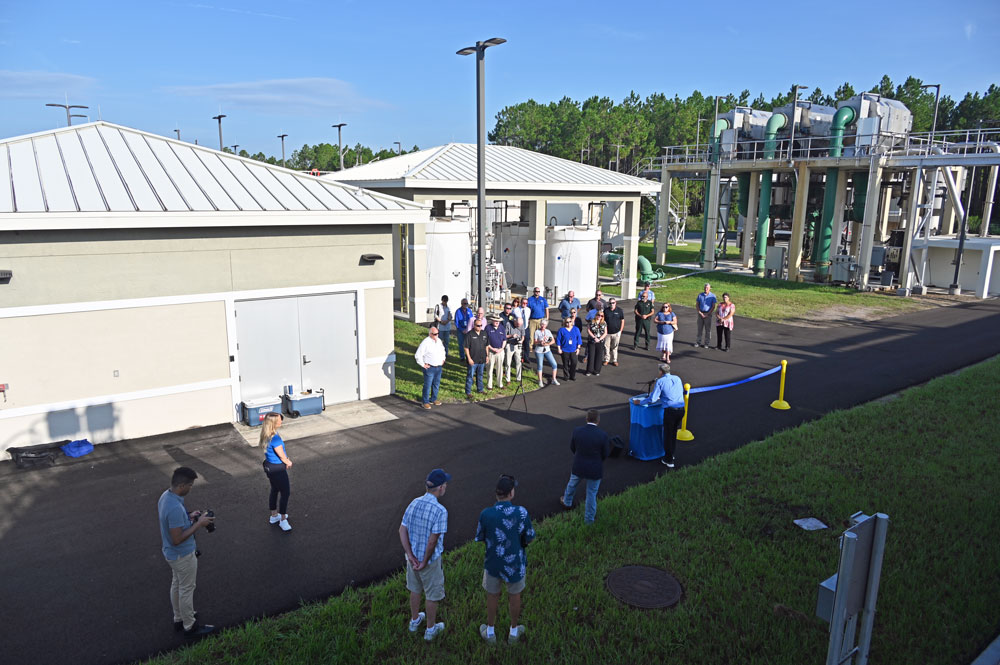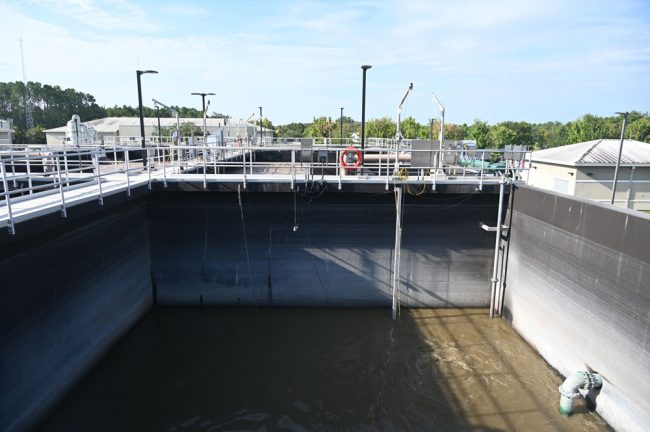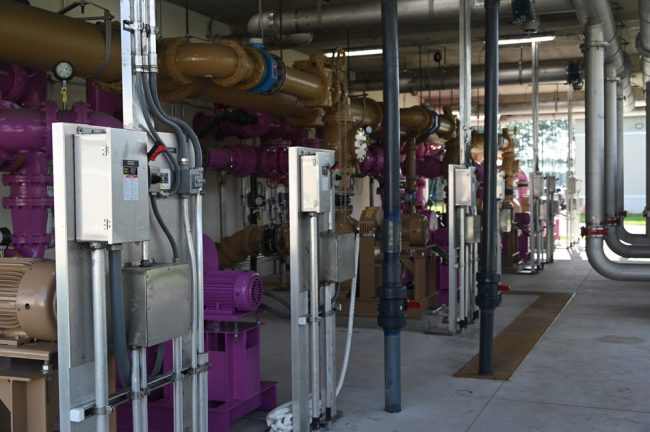
Almost three years late and 55 percent over the original budget, Palm Coast’s expansion of its Waste Water Treatment Plant Number 2 is now operational but for a punch-list, doubling the plant’s capacity to 4 million gallons per day and relieving the city’s older, overburdened WWTP1 in the Woodlands, which is getting its own expansion.
City officials–including mayor Mike Norris, whose appearance at a public event was noteworthy–utility personnel and a few others gathered for a ribbon-cutting this morning to mark “a project that represents not only progress to infrastructure, but also our community’s commitment to growth, sustainability and public health,” Peter Roussell, the utiliy’s chief operator, said.
The original Wastewater Treatment Plant 2 cost $30 million when approved for construction in 2015. When presented to the City Council in January 2020, the expansion was scheduled for completion by November 2022, for $20 million. Not including design, the project’s construction cost rose to $30.9 million, financed with a loan through the Florida Department of Environmental Protection at 0.67 percent. In turn, the loan is financed by development impact fees, though the promise by the city manager in 2020 that the expansion would not cost current residents proved elusive. In 2018 the council approved a 20.8 percent increase spread over four years, and last year approved a 31 percent increase over three years. So while impact fees certainly finance the loan, “your rates are what pays for these expansions,” the mayor said.
The Utility Department’s Steve Flanagan attributed the construction delay to Covid and unreliable supply chains, a city spokesperson said. The pandemic shook the economy less than three months after the city presented its plans for expansion to the council.
The expansion provides huge relief to the city’s sewer infrastructure, and in turn relieves potential constraints on development. The infrastructure–namely, WWTP1–has often been over capacity during torrential rain events. WWTP1 is under a state consent order to expand.
“Overcapacity” can be a misnomer and is often misinterpreted by the public. When WWTP1 is overcapacity, it does not mean that it is unable to process incoming flows, or that toilets back up. Neither happens. (Your pep tank may cause backflows, but only when power cuts prevent it from emptying out to the nearest pump station.)

Rather, the system does not process every gallon at the same rate that it should to meet environmental standards (though neither does the stormwater entering the system carry the same concentration of treatable effluence). The city during such events asks residents to limit their water use to ease that pressure–not because the system is not functioning.
The expansion at WWTP2, off U.S. 1 in the northwest corner of the city (where the ill-fated fuel dump would have been located) allows up to 800,000 gallons a day to be redirected from the older plant, which currently has a capacity of 6.83 million gallons per day and is expanding to 10 million. In 2020, utility officials told the county that the plan was to redirect flows from the Pine Lakes area to the newer plant at expansion. It can also accommodate stormwater surges.
WWT2 produces “reuse” or recycled water used on lawns in many parts of the city. Hammock Beach Resort is among the city’s bigger reuse customers, says Mike Baldwin, the chief operator of the newer plant. He took a small group of people on a tour of the new infrastructure, showing the “train” of tanks that filter effluents from their raw form, when they first enter the plant, to treated product, with live bugs doing much of the treatment along the way. The new construction includes a pair of 400,000-gallon equalization tanks that are especially useful during storm surge events, when huge flows of stormwater must be processed.
The ribbon-cutting took place in the shadow of the roughly two-story high, football-field-sized “train” of sewer tanks that represent the bulk of the expansion. One of the new construction’s distinctions is its “smaller footprint,” Baldwin said: it takes up less space to accomplish more, and it’s no small matter that it does so with surprisingly limited odors.
Baldwin explained the newer “advanced wastewater treatment” technology that uses a membrane-treatment process, with all flows going through a membrane that filters out most debris before the flows are treated. The AWT standard must be met to allow any excess water not used on lawns to be discharged in wetlands.

Though the city faces several hundred million dollars in needed water and sewer infrastructure needs, last spring the legislature awarded Palm Coast $5 million for its wastewater project, including half that amount for a new equalization (or holding) tank in addition to the infrastructure at WWTP2.
“Today is about more than just pipes and concrete,” Roussell said. “It’s about preparing and planning for the future. That’s what we’re doing here, preparing for the future, for businesses, for families in the neighborhoods that have grown right alongside of us. As our population increases, so too does the need for resilient systems that support our daily lives and protect the environment that we all share.”
The occasion was newly-appointed Community Development Director John Zober’s first appearance. “We want to keep infrastructure ahead of need, so it’s ideal. It helps make our job a lot easier. You don’t want to be chasing capacity,” he said.





























Janet Sullivan says
Best headline ever.
Adam Friedland says
I’m releived too.. relieving myself as I read this
Liquid Gold says
Oh great – I bet our rates will go up another 4589767800454% again in like a year. One of these days in the what will be heavily taxed overpriced water of our future, I’ll miss the retention pond water they push out to our houses currently for top, top, top dollar.
Dennis C Rathsam says
The city is still relieves an over abundance of my nest egg every month! So happy Sidney Sweeney is a member of the GOP!
Ed Danko, former Vice-Mayor, PC says
WOW! Norris actually showed up to cut a ribbon, and then he fled as fast as he could instead of taking the tour with everyone else. Flush twice, it’s a long way to the Mayor’s empty office!
JC says
Dennis C Rathsam: What a weirdo. Talking about a random chick on a news article about the Sewer Plant Expansion. I guess his boomer mind is slowly not working anymore.
Dianne says
Why aren’t the builders of these developments paying for this? Why are we the homeowners paying for this? Something isn’t right here…keep on raising our rates and all those new homes will remain unsold…the whole council board needs to be removed…their actions and decisions are killing the residents of Palm Coast
We need an audit says
Maybe we should have DeSantis send the state DOGE to Palm Coast to track down what happened to the impact fee money that was supposed to pay for these improvements
FlaglerLive says
Impact fees are paying for the improvements.